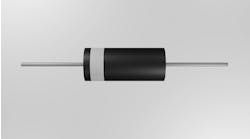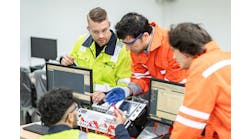The general trend over the past 5-10 years points at an emerging preference of programming languages over traditional ladder logic for machine control. While there have always been those who spout the benefits of structured text (ST) over ladder logic (LAD), the waters are further muddied by what I would call a merging of PC-based programming with automation programming.
As the availability of trained, PLC-based technicians and engineers dwindles, the void is being filled, although at a slow rate, by graduates of software-applications programs at the university level.
The change in direction, it seems, has long been anticipated by automation manufacturers as the development of the standard IEC 61131-3 is all about opening up the platform to use alternates to the LAD approach to writing a control algorithm.
As a “classic” programmer, I have long suspected structured-text-based algorithms of being overcomplicated gobbledygook designed to push us vintage code developers out of the mainstream. While I studied the early structured languages in college, I have always felt that LAD was easier to troubleshoot for those who didn’t have specific programming training.
I do, however, acknowledge that structured languages are far more powerful as a programming tool when the need arises. My firm grip on LAD as a programming base is founded on my observation that I haven’t run across much in the packaging-machinery business that demands more than LAD can provide.
A search of online sources will indicate that the most popular programming platforms these days are Java, C, C++, Python and C#, with VB, SQL and Assembly much further down the list in a category of less than 2% usage compared to the top five on the list.
Automation vendors must clearly see that to keep their share of the market, automation controllers must have the ability to incorporate these programming standards into the platform or risk losing ground to the PC-based controllers.
Call me an old guy, but after all these years of having them around, I still haven’t looked at a PC-based control platform as anything other than an attempt by a home-computer provider trying to tap into the automation market. There are some fine manufacturers of industrial PCs, but something just doesn’t feel right to me about deploying these in the field when they find their origins on a desktop device.
A look into the evolution of packaging machinery shows some interesting trends. Early packaging equipment was relay-based technology. Timing was maintained using mechanical cams, much like machines have used since the dawn of the industrial revolution. During the late 1960s and through the 1980s, machinery providers embraced the advent of the computer chip to reduce the use of relays and wiring by basing their designs on these early processor chips and developing printed circuit boards to interface with the real devices on a machine.
Once down that path, machinery providers had no choice but to follow the initial investment in this technology by continuously improving their use of the technology to the point where the control system was a complicated system that only electronics experts could support.
For the end user, these systems were beyond the skill level of most maintenance providers. Product support involved calling the manufacturer to discuss the problem and, in many cases, purchasing replacement components to be plugged into the black box of a control system.
With the development of the PC in the early 1980s came the co-development of the PLC. Computer-based controls, with a relatively easy programming language, LAD, stuffed into an industrial package that could be mounted in a control box on a machine, provided a means of reducing some of the complication of the control system and a means by which the end user could step up the ability to troubleshoot issues and arrive at solutions without great involvement or cost from the original vendor.
While PLCs became the mainstream control method for machinery, processor-based controls for essential devices such as checkweighers and metal detectors kept these devices in the black-box realm until recently.
With the ever-evolving technology in the PLC-based world, some manufacturers who have successfully deployed PLCs in past have taken on the chip-based applications with new PLC technology. The results are a win for the end user as the solution removes the mystery of the black box.
I had the opportunity just recently to experience such an innovation when a well-known OEM in the auger and volumetric filler business came out with a PLC-based checkweigher. Now those who have been in the business for a while might immediately blurt out that this can’t be done. Fast response times and accuracy of samples are the realm of PC-based quality control.
Well, this oldtimer was very surprised to learn that not only was the PLC-based platform fast, it was degrees more accurate than our other weight-measuring equipment. We observed decimal accuracy on very light pouches in a particular application that was astonishing.
So, here’s where this starts to get interesting. As a contract packager, we have a large inventory of checkweighing equipment, some of them at least 20 years old. While we have good intentions, the fact is we aren’t as quick to replace this older equipment due to simple economics—remembering the old adage, “If it ain’t broke, don’t fix it.”
This policy works for a time, but suddenly we find ourselves having more and more difficulty making repairs to this equipment. These are all circuit-board level, microprocessor-based devices, and, while the cream of the crop when we first purchased them, time has passed them by.
The general tendency of folks in the checkweighing and other key product-monitoring business entities is to follow the PC-based technology. Let’s think about that for a moment.
PCs have been around for about 40 years. Much has changed from those early days. The processors get smaller and faster. The capabilities get greater. Operating systems seem to have a 3-year lifespan, and that usually means having to change or upgrade the hardware platform soon after, as the hardware folks are busy supporting the new operating system and don’t want to spend much time and resources on supporting what is now a legacy item.
Unlike a PC investment at $800-$1,500 or so, a checkweigher or other such device costs tens of thousands of dollars. If the hardware or operating system is going to improve every 3-5 years, how does the end user keep up with that advancement? Well, the truth is they don’t. They end up spending money on replacement boards and third-party repairs to keep that investment going.
With a PLC-based device, the expectation is that the platform is going to be around more than a few years. Sure, there will be firmware updates, but the structure of the base platform will remain the same.
Look at the legacy of the Allen-Bradley PLC-5 or SLC 500 from Rockwell Automation; the Siemens Simatic S5 and S7 series; or Schneider Electric’s Modicon 84 series. The original company name, Modicon, was derived from modular digital control, and that is the emphasis here—everything is modular. The processors improved over the years but the ability to plug new technology into the same platform is a key attraction to a PLC-based system.
Now I’m not saying there isn’t a place for PC-based control. In my experience, critical control systems for energy production, nuclear power plants, the aerospace industry and other similar pursuits will always have a need for the PC-based systems. These types of systems require constant improvement, and the dependency on an anchored base platform would prohibit such endeavors.
However, for general manufacturing such as food, beverage, automotive and other consumer goods, a base platform that can be easily added to or upgraded makes a lot of sense.
The PLC is quite capable of fighting back and holding its own. Automation companies that have been lured into the PC-based market by the abundance of graduate programmers from the IT world are starting to find ways to slide back into the comfortable clothes that is the PLC platform.
Our experience with the PLC-based checkweigher has inspired us to look at a wholesale replacement of our legacy equipment on a much more aggressive timeline than has been our policy to date. We have long lamented the short lifespan of our quality-assurance investments, and the emergence of a product based around a platform that is intended to last for a decade or more is extremely attractive to us.
It will be interesting to see where this trend leads. The labor crisis we now face hits all aspects of the business. Production workers and skilled laborers are in high demand, and even the machinery makers are feeling the pinch. If they can use their current skilled staff, familiar in a PLC-based control system, and develop products that are outside of their traditional product lines, the opportunities for continued growth will provide jobs and revenue for years to come.






